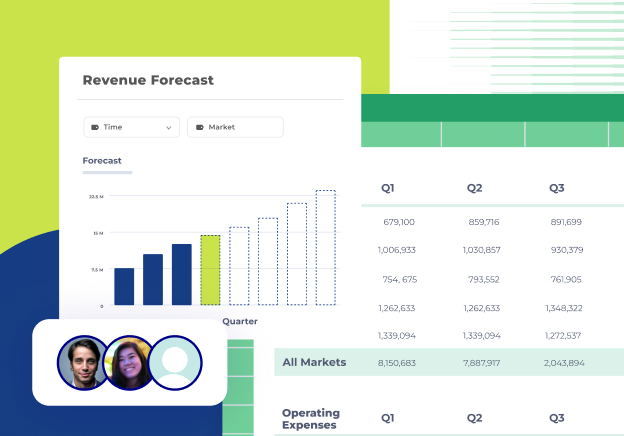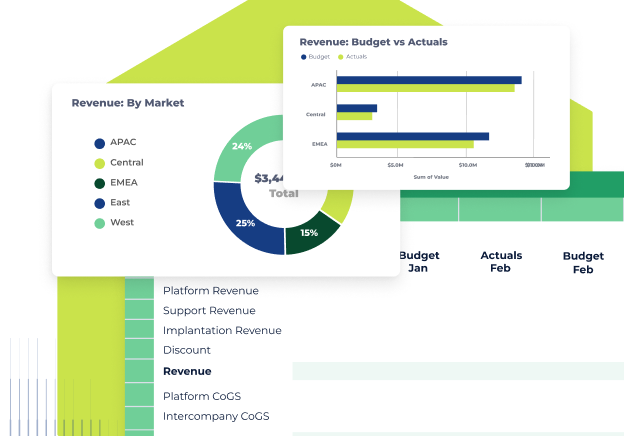What is adjusted EBITDA?
Adjusted EBITDA removes one-time, irregular, and non-recurring items that distort EBITDA.
Quick refresher: EBITDA is Earnings Before Interest, Taxes, Depreciation, and Amortization.
(And EBIT is EBITDA less depreciation and amortization).
What's the difference between EBITDA and adjusted EBITDA?
Since EBITDA measures a company's earnings, it's an overall indicator of that company's profitability. The higher EBITDA, generally, the more profitable a company is.
But one of the downfalls of EBITDA as a comparison metric is that two companies can have the same EBITDA but vary in terms of how leveraged they are.
So adjusted EBITDA—also called normalized EBITDA or standard EBITDA—removes irregular and non-recurring items that might distort a company's EBITDA.
Why use adjusted EBITDA?
Adjusting EBITDA gives a normalized number undistorted by irregular gains, losses, or other items.
In other words: it's a more fair, standard measure of a company's finances. It gives stakeholders a clearer picture of a company's true operational performance, making it a valuable tool for:
- Financial analysis and decision-making
- Assessing potential investment acquisitions
- Showing banks whether you’re able to pay off debts
This means a sharp improvement in adjusted EBITDA can position a company above its competitors in a side-by-side comparison.
Financial analysts, investment bankers, and finance professionals use a company's adjusted EBITDA during valuation.
What's excluded in adjusted EBITDA?
Adjusted EBITDA presents a clearer view of a company's operational performance by excluding certain items that may distort its earnings. Here’s a closer look at the common exclusions in adjusted EBITDA:
- Non-operating income and expenses. These are items not directly related to the core operations of the business. Examples include investment gains or losses, which can vary significantly from period to period and do not reflect the company’s regular business activities.
- Unrealized gains or losses. Unrealized gains or losses from investments or foreign exchange fluctuations can be volatile, so mislead assessments of a company's operational performance. Adjusted EBITDA excludes these to focus on more consistent revenue streams.
- Non-cash expenses. Depreciation and amortization are non-cash expenses that are included in the traditional EBITDA calculation but can be excluded in adjusted EBITDA. This helps to provide a clearer picture of cash-based profitability.
- One-time gains or losses. Any extraordinary items that do not recur regularly, such as a gain from the sale of an asset or a loss from a lawsuit, are usually excluded. These events can create significant fluctuations in profitability, but as one-off changes, they’re left out of an adjusted EBITDA.
- Stock-based compensation. While stock-based compensation is a real expense, it’s normally omitted from adjusted EBITDA because it doesn’t involve a cash outflow. That said, some analysts may include it depending on their analysis approach.
- Litigation expenses. Legal costs can be unpredictable and significant, especially if you’re facing a major lawsuit. These expenses are often excluded to prevent them from skewing the company's operational performance.
- Special donations. Large charitable donations or other non-operational, discretionary spending are typically excluded to keep the focus on the company’s core financial performance. On the other hand, regular monthly donations are predictable and would therefore be included.
- Above-market compensation. In the case of private companies, owner’s compensation that is above market rates might be excluded to normalize the company's earnings. This adjustment reflects what the company's performance would look like under standard compensation practices.
- Goodwill impairments. If a company writes down the value of goodwill on its balance sheet, this non-cash charge is usually excluded from adjusted EBITDA to avoid distorting the company’s operating performance. Excluding goodwill impairments helps maintain a focus on the company's actual earnings from ongoing business operations.
- Asset write-downs. Similar to goodwill impairments, any write-downs of assets, such as inventory or equipment, are typically excluded as they do not reflect the ongoing operational performance. Instead, they look at depreciation over time.
What are the limitations of adjusted EBITDA?
Adjusted EBITDA, while more reliable and normalized than EBITDA, still has two big caveats.
First, there's no standard or universally agreed-upon list of what can and cannot be included in the adjusted EBITDA calculation. So bad actors can corrupt (or "denormalize") their adjusted EBITDA with some creative accounting.
Adjusted EBITDA's second limitation is that it's not reflective of cash flow, which is an essential overall indicator of a company's financial health.
So you should always consider adjusted EBITDA in the context of at least one other financial metric.
How to calculate adjusted EBITDA
Fortunately, calculating adjusted EBITDA is pretty easy. It's just EBITDA plus or minus adjustments.
Adjusted EBITDA = EBITDA ± Adjustments
If you need a refresher on calculating EBITDA, it's net income + interest + taxes + depreciation + amortization. You can find these on your company's income statement.
Okay, great. But how do you know what those adjustments are?
Common non-recurring expenses and adjustments
Adjustments are one-time expenses (including interest expense) and other nonrecurring expenses.
Here's a non-exhaustive list of common EBITDA adjustments:
- Non-operating income
- Unrealized gains or losses
- Non-cash expenses
- One-time gains or losses
- Stock-based compensation
- Litigation expenses
- Special donations
- Above-market owners’ compensation (private companies)
- Goodwill impairments
- Asset write-downs
- Rentals above or below fair market value
- Foreign exchange gains or losses
Always keep a list of what you've included in your standard EBITDA calculation. Since this is a non-GAAP metric and there's no "standard" way to decide which goes in and what's left out, you might be asked to show your work.

Example of how to use adjusted EBITDA
To look at adjusted EBITDA in practice, let’s take a hypothetical company, ABC Real Estate, which has reported an EBITDA of $5 million for the fiscal year. However, this figure includes several non-recurring items that could distort the company's true operational performance.
To provide a clearer picture, we need to calculate the adjusted EBITDA. Here’s the breakdown:
- One-time legal settlement. ABC Real Estate had to pay a $500,000 settlement for a legal dispute that was resolved this year. Since this expense is non-recurring, it should be excluded from the EBITDA calculation.
- Asset write-down. The company also wrote down $300,000 worth of obsolete equipment. This is a non-cash expense and not indicative of the company’s ongoing operational performance, so it’s excluded.
- Stock-based compensation. ABC issued stock options to its executives, amounting to $200,000. Although this is a real cost, it’s a non-cash expense and is often excluded in adjusted EBITDA calculations to better reflect cash-based profitability.
Now, let’s calculate the adjusted EBITDA:
- Reported EBITDA: $5,000,000
- + Legal Settlement: $500,000 (added back)
- + Asset Write-Down: $300,000 (added back)
- + Stock-Based Compensation: $200,000 (added back)
Adjusted EBITDA
$5,000,000 + $500,000 + $300,000 + $200,000 = $6,000,000
Although irregular items are unavoidable in business, the adjusted figure of $6 million is the most useful one for investors and analysts when comparing ABC Real Estate to other companies.
Adjusted EBITDA vs. a company's net income
Confused about the difference between adjusted EBITDA and a company's net income? You're not alone. But fortunately, the difference is pretty clear once you break it down.
Adjusted EBITDA is calculated using the formula: Adjusted EBITDA = EBITDA ± Adjustments. EBITDA itself is derived from net income by adding back interest, taxes, depreciation, and amortization.
Therefore, adjusted EBITDA is essentially net income plus these additions and any further adjustments for non-recurring or non-operational items. Because adjusted EBITDA includes these extra components, it will almost always be higher than net income.
Adjusted EBITDA vs. cash-adjusted EBITDA
You might have been asked for your company's cash-adjusted EBITDA—particularly if you're in SaaS.
Cash-adjusted EBITDA is another variation on the standard EBITDA: it's when you add the year-over-year change in deferred revenue from the balance sheet to EBITDA.
In other words, cash-adjusted EBITDA previews your company's future EBITDA.
Cash-adjusted EBITDA has a lot in common with normalized EBITDA.
It's an EBITDA modification that presents your company in its best light.
And it's also a standard valuation multiple.
What is cash-adjusted EBITDA? How do you calculate it?
The formula for cash-adjusted EBITDA is a little more complicated than the formula for adjusted EBITDA, but it's still super simple.
Here it is:
Cash-adjusted EBITDA = 12-month trailing EBITDA + YoY change in deferred revenue
Let's break it down:
12-month trailing EBITDA is the average EBITDA for the previous twelve months.
The YoY change in deferred revenue is the change in deferred revenue from the beginning of that 12-month period to the current month. This is the "cash" that cash-adjusted EBITDA accounts for.
Adjusted EBITDA and EBITDA multiple
EBITDA multiple is a financial ratio that measures how desirable a company is to acquire. It's also known as the EV:EBITDA ratio, where EV is enterprise value.
Here's how to calculate it:
EBITDA multiple = EV ÷ EBITDA.
The question is: Is it better to use EBITDA or adjusted EBITDA in this calculation? The decision to use adjusted EBITDA in calculating the EV ratio largely depends on your specific goals.
Since a smaller EV ratio is generally better, and adjusted EBITDA tends to be higher than standard EBITDA, many companies use adjusted EBITDA to make their EV:EBITDA ratio look better. By using the higher adjusted EBITDA figure, a company can improve the perception of its value in comparison with others in the industry.
And there's a solid argument to be made that it's better this way, too. Since adjusted EBITDA removes the randomness from EBITDA, an EV:EBITDA ratio that uses it is better for investors who want to compare companies.
But if you're trying to sell your company and that valuation uses some multiple of the EV:EBITDA ratio, you want to use the regular EBITDA because it'll yield a higher EV:EBITDA ratio, thereby increasing your company's purchase price.
The bottom line on adjusted EBITDA
Now that you have a solid understanding of adjusted EBITDA—what it is, how to calculate it, and how to use it—you can use it to enhance your financial analysis.
Cube is the first spreadsheet-native FP&A platform that connects with all your source systems, organizes and cleans your data, and lets you work in both Excel and Google Sheets.
If you want to save time and improve your FP&A processes, click the banner below for a free demo.




.png)









.png)

.png)


.png)
.png)
.png)